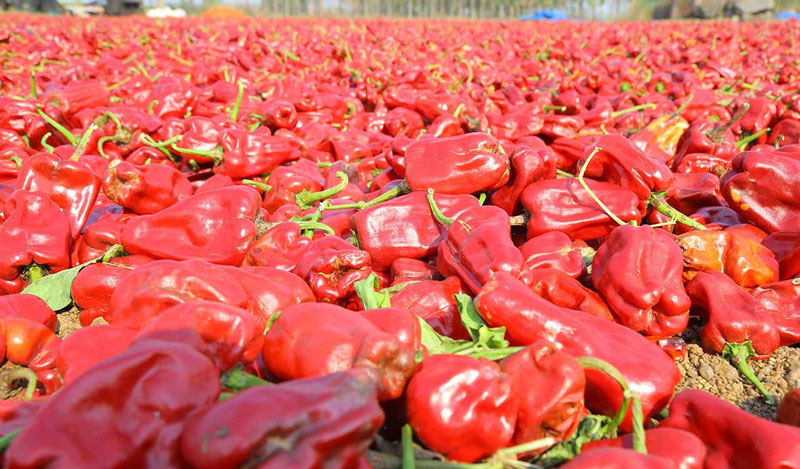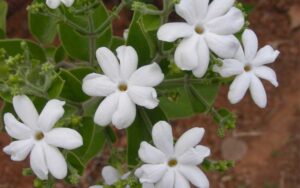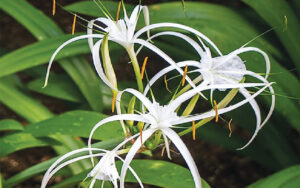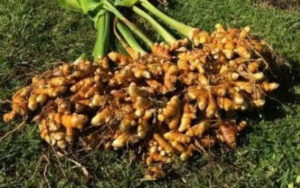Parijat: A tree of heaven
Ms Saryu Trivedi
Ph.D. Research Scholar
Dept. of Floriculture and Landscape Architecture
ASPEE College of Horticulture
Navsari Agricultural University
What is Parijat?
 Parijat (Nyctanthus arbortristis Linn.) commonly known as night jasmine, a wonderful plant is described in Ayurveda with it’s enormous medicinal value. Other than Parijat it is popularly known as Har-shinghar.
Parijat (Nyctanthus arbortristis Linn.) commonly known as night jasmine, a wonderful plant is described in Ayurveda with it’s enormous medicinal value. Other than Parijat it is popularly known as Har-shinghar.
Different parts of this plant are used for various medical purposes. It’s leaves have broad spectrum medicinal use such as anti- bacterial, anti-inflammatory, anti-pyretic and anti-helmentic effect. The descriptions of habitat, morphology, etymology, traditional pharmacology, therapeutic use etc. are richly found in Ayurvedic literatures.
Chemical constituents of parijat plant
| Leaves | : | The leaves of Parijat has D-mannitol, ascorbic acid, nyctanthic acid, β-sitosterol, nicotiflorin, tannic acid, an amorphous resin and glycoside, carotene, mannitol, glucose, fructose, benzoic acid, iridoid glycosides and a trace of volatile oil. |
| Bark | : | The grey bark of Parijat plant has alkaloids and glycosides. |
| Flowers | : | Parijat flowers have sweet honey fragrance and are rich in D-mannitol, glucose, carotenoids, tannis, essential oils and a few glycosides including D monoglucoside ester of α-crocetin, α-crocetin (or crocin-3), β-monogentiobioside-β-, and β-digentiobioside ester of α-crocetin. |
| Flower oil | : | The flower oil of Parijat contains 1-hexanol, β-sitosterol and glycoside naringenin. |
| Plant | : | The Parijat plant has iridoid glycosides, arbortristosides A, B, and C, 2,3,6 tri-0-methyl-D-glucose, 2,3,6-tri-0-methyl-D-mannose, 2,3,4,6-tetra-0-methyl-D-glucose and 2,3,-di-0-methyl-D-mannose. |
| Seeds | : | The seeds of Parijat have a water-soluble polysaccharide made of D-mannose and D-glucose along with arbortristosides A and B, nyctanthic acid and glycerides. |
| Set full of leaves…among which come forth most odoriferous and sweet-smelling flowers, whole stalks the colour of saffron, which flourish and show themselves only in the night time, and in the daytime look withered and with a mourning cheer: the leaves also at that time shrink in themselves together…very sadly lumping, lowering, and hanging down the head, as though it loathed the light and could not abide the heat of the sun.” |
– John Gerard (The Herbal 1633)
Past and present context of Parijat
 India Post had released two stamps in 1997. One of these, 5/- stamp, bore the image of a tree, unmistakably a Baobab, with an inscription which said “Parijat tree”. The other was 6/- stamp which carried the image of pentafoliate leaves and a pentamerous flower, with the same inscription. It was released by the national postal service, India Post, these stamps carry the credibility of the government of India.
India Post had released two stamps in 1997. One of these, 5/- stamp, bore the image of a tree, unmistakably a Baobab, with an inscription which said “Parijat tree”. The other was 6/- stamp which carried the image of pentafoliate leaves and a pentamerous flower, with the same inscription. It was released by the national postal service, India Post, these stamps carry the credibility of the government of India.

















